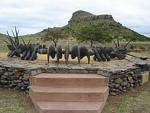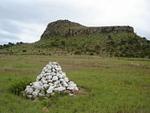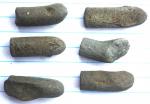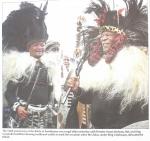-
Posts
13,225 -
Joined
-
Last visited
-
Days Won
22
Content Type
Profiles
Forums
Blogs
Gallery
Events
Store
Everything posted by Mervyn Mitton
-

Union Jack Flag help
Mervyn Mitton replied to paul kennedy's topic in Great Britain: Militaria: Badges, Uniforms & Equipment
The 6 feet size (180cm) is the usual size for a building - it also fits nicely over a coffin for services. I think this will be civilian of indeterminate age. Mervyn -

WInston Churchill - Part 3, In the Skies of Britain
Mervyn Mitton commented on Brian Wolfe's blog entry in News From the Home Office.
Brian - a well written continuation to this important look back on Winston Churchill. Your historical facts and their presentation are excellent and combined with the biographical side, brings the story along very well. Congratulations for your perseverance , research and the ability to make this such an interesting story - despite all the many previous histories. I very much look forward to your next in the series. Mervyn -

Glider Pilot Regiment
Mervyn Mitton replied to Spasm's topic in Great Britain: Research, Documentation & History
Steve - I used to know an old chap in our village who was a trained glider pilot and who had been at Arnhem. For some reason he sold me all of his badges , unfortunately I no longer have them. I remember him saying that the gliders were dreadful machines to control and many of them went out of control and crashed. As I said he was at the Arnhem disaster and was one of the final ones to escape. Although wounded he managed to swim across a canal and was rescued and taken to safety by the Dutch Resistance. He said he was in the last half dozen to get away. He used to come-in and have coffee in the shop quite regularly , however, like many British pensioners he returned to the UK for the National Health Service. I suppose he has passed away by now - his wife was unwell also. A brave and very pleasant man who did his duty under very difficult conditions. Mervyn -
Hi -terrylee. Thakyou for your reply. You are obviously an expert in this field and I accept what you say. I wanted to show the 1879 model and specifically looked for this - the photo and explanation stated that it was the model I was looking for. I will not change it at this time - it will give readers the general style and shape of a Martini Henry. However, should you have a correct picture you could send me, then I will substitute. Many thanks. Mervyn
-
Brett - you have found some nice pieces for your son's collection. The spoon - used for Maas - may be a more modern copy. However, the shape looks fine. (For those overseas Maas is a local yoghourt) Coming to the weapons - the knobkerry has a waisted top - this is usually from the early part of the 20th. C. The longer stick is an Iqhabanga - or, Kraal stick of office for a chief. Obviously could be used as a weapon, but really more status. The running shape cut out around the body dates it to about 1906 - they started to do this to their spear shafts. The first Assegai or Umkhonto is a hunting spear for large buck. The binding is a cow's tail - peeled off and then slid over the shaft. This may be a replacement - but like medal ribbon, they were meant to be re-placed when worn. Very good blade with correct pincer marks and it has age. The next is an Isiphapha or throwing spear. There are only two 'Battle' spears - the Iklwa and the Isiphapha. Both names are onomatopaedic , or the sounds they make. Iklwa for when it is pulled from the body and Isiphapha for the noise it makes when in the air. This has the Ilala palm woven binding. The shaft has had damage to the base at some time and has had the end cut away - this is why it is a little shorter. This is common damage and does not detract from the value. The last spear shows how tthe end would have looked. Finally, the last spear. This is an exceptional weapon. I would judge the blade to be approx. 18" long (50cm) - which is quite rare - and that doesn't include the neck of the head. The shaft is a lovely local wood - well shaped and with the correct end. The only reservation I have is that the binding is mine fuse wire. However, we have to bear in mind that most Zulu men were working in the mines - and when they returned weapons had to be repaired to start killing each other. So, minewire is acceptable, but not correct. From the photo I think the spear is old and original in condition - apart from the binding . This could easily date to the 19th C. Hope this helps. Best wishes Mervyn
-
Peter - I have heard of the cuts on bullet heads to make them expand on striking - however, I have looked again at the ones on display and I think the cuts are in fact damage from striking at an angle. The area of the Battle has rocks around - also, an angle hit on bone could probably have the same effect. The lead was not fully clad. After the Battle the Zulus had more Martini Henry's and ammo. then we did. They used them on the Oscarberg overlooking Rorkes Drift. Fortunately for our troops the sights were set for close firing and most of the shots were inaccurate. Mervyn
-

6 part medal bar
Mervyn Mitton replied to Leuchtturm's topic in Great Britain: Orders, Gallantry, Campaign Medals
Chris - I would say two possibilities. 1. Made-up for use by a veteran or, 2. A fake set. Since none have naming I doubt if you will ever know for sure. Mervyn -
One doesn't see many LSGC medals for Police - I think with Police not getting a lot of service medals, that these become treasured by the families. I'm afraid that I haven't done any research on this pair - thankyou James for reminding me that it was 22 years service. I was obviously thinking of the 25 for retirement. Interesting about the possible pension loss on premature retirement, Robin. I did 7 years service in the Met. and left to takeover the family business when my Father died unexpectedly - he was only 64. However, most off my friends hung on grimly, to get their 30. Mervyn
-
Well, there you are Stuka - thanks to Strapper you've got all the info. you need. Obviously a well known name to collectors - so, try a good auction house. Let us know what they say. Mervyn
-
I'll contact Hardy and see if he can help ? This is a subject many are unsure about. Mervyn
-

Iconic Firearms - what do you think?
Mervyn Mitton replied to Brian Wolfe's topic in Firearms & Ordnance
Brian - good description and illustrations of an important change in firearms. From these developed the Tranter and Adam percussion Revolvers - and of course the Colt's which changed history. We need more of this type of descriptive article. Mervyn -
http://gmic.co.uk/uploads/monthly_01_2015/post-6209-0-73472400-1422444331.jpgclick Part of the Bronze Zulu Memorial at Isandlawana - made to look like a bravery lions claw necklace. http://gmic.co.uk/uploads/monthly_01_2015/post-6209-0-11232000-1422444540.jpgclick One of the maany stone cairns which dot the Isandlawana Battlefield to mark British burials.
-
This now leads us to look at King Zweletini's statement that only 1000 Zulus were killed by the British at Isandlawana - and that they should have a Memorial with names. This is nonsense - some years ago - probably about 15 - they built an enormous circle with bronzes, to commemorate the fallen Zulus. Many of the leaders were named , but I don't think the fallen warriors were. The simple reason being - despite what the King has said - they don't know the names of the majority who fell. Quite simply there was no register of births and deaths. Over the years I have watched the suspected number of Zulu deaths be whittled down from around the 5000 number , to the present number given at 1000. We actually have no count of the Zulu dead - they carried away the dead and wounded. Most were concealed in white ant mounds and if they reached their villages would have recovered or, been buried there. I have seen several tallies over the years - however, it is generally accepted by most historians that the total was between 2000 and 5000. Remember - there were some 23,000 Zulus , against approx. 1200 British soldiers - mainly from the 1st and 2nd Battalions of the 24 th Regiment. Highly trained men who carried the most modern rifle - with the very heavy 450/577 bullet. This was quite capable of going through three men at close quarters - and this was such a battle - fought at the end as hand to hand. No - I think I reject the King's speech as being made in a political context. I will be pleased to hear what Members think ? Mervyn
-
http://gmic.co.uk/uploads/monthly_01_2015/post-6209-0-56256400-1422442342.jpgclick http://gmic.co.uk/uploads/monthly_01_2015/post-6209-0-56350100-1422442440.jpgclick http://gmic.co.uk/uploads/monthly_01_2015/post-6209-0-79605200-1422442570.jpgclick http://gmic.co.uk/uploads/monthly_01_2015/post-6209-0-87341900-1422442697.jpgclick
-
http://gmic.co.uk/uploads/monthly_01_2015/post-6209-0-11353700-1422440852.jpgclick http://gmic.co.uk/uploads/monthly_01_2015/post-6209-0-58348900-1422440991.jpgclick Rear and front views of some bullets picked-up in the 1920's on the Battlefield of Isandlawana. From the 1960's it became illegal to collect from designated sites - however, these and others I have are from this earlier time - only some 45 years from the Battle. They are exceptionally rare and I have never shown them before - PLEASE NOTE I RETAIN COPYRIGHT.(members are welcome to use) Fought on 22nd of January 1879 , the Zulus had between 23 /25,000 men , whilst the British Forces numbered some 1800. However, the Native Levies fled and our Artillery was over-whelmed - so, we had some 1200 men to fight the Impis. The loss was the greatest we ever suffered in the Colonial Wars. http://gmic.co.uk/uploads/monthly_01_2015/post-6209-0-12309600-1422441846.jpgclick This is the 1879 Martini Henry Rifle - single shot , lever action - used at the Battle. It fired a lead bullet - a 450/577 size. (The following pictures are close-ups of some of the bullets - hard to tell if they hit rock or bone. I suspect that most hit their targets)
-
We are still having a lot of members and guests view this post on the Zulus and their history. I will therefore, continue with it and post items of interest as they come to light. The next one, about the Zulus demanding a memorial for their "1000" killed at Isandlawana, is an example of how history is changed to suit political 'needs'. I need to show some photos of the ammunition used at this battle - my answer might take a few days. Mervyn
-
KLeek - please accept my sincere apologies for overlooking your questions. Looking firstly at Iklwas - these started off under King Shaka at about 4 feet long (120cms) - however, they were not mass produced and really it was left to the owner to decide size. If he was a tall Zulu then often the spear would be longer. Axes were usually only carried by senior chiefs. They were expensive and used more for status. They can be anything from 4 feet to about 5.5 feet. (120cms to 120cms) Iwisa (Knobkerries were mainly used for close action and so averaged about 4 feet (120cms) With regard to Shields thay had only two for war. The largest was the Ishilangu - this could be up to 6 feet (180cms). Made from bull hide it was heavy to carry and was more for ceremonial work. For longer distance fighting they had a shorter shield known as an Umbululu. This was about 4 feet high and was lighter (120cms) When fighting they would usually carry the Iklwa in the right hand. The left hand held the shield and behind the shield they would usually carry two throwing spears and the Iwisa. The would change the Iklwa to the left hand as needed. I hope this helps with your questions ? Best wishes Mervyn 27/1/15
-
Rob - until you have completed a certain number of posts, there are a few limitations. Not to worry, the additional information goes with the original post. An interesting officer , with a great history. Mervyn With regard to Commendations - these can be given at different levels. Were you thinking of the British Mentioned in Despatches ? These are often included in the Govt. Gazette for the period. Perhaps some of our Research members may be able to help you ? Best wishes Mervyn
-
Thankyou militarybadge - welcome to GMIC - and I apologise for this change. We just felt it was lost on the Blog. Oudtshoorn is a lovely small town in the Eastern Cape - on a map it is inland to the left of Port Elizabeth. The area has always been famous for Ostrich rearing and it was the centre for many years. The Oudtshoorn Volunteer Rifles were formed in 1890 and were originally 'G' Company of the Western Province Rifles. In 1897 they served in the Langberg Campaign . 1904 saw them presented with a King's Colour and by 1908 they were two Companies strong. For the Coronation of King George 5th, they were honoured by having their Band and a contingent of troops sent to take part in the Coronation ceremonies. They were disbanded in 1913. From 1891 they wore Line Uniform - with white helmet and shoulder straps. For field dress they wore khaki and a slouch hat. The Badge - shown above was the Arms of the Cape - with the motto 'Spes Bona'. My ref. has been Major Tylden's - The Armed Forces of South Africa. Mervyn















